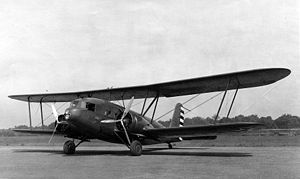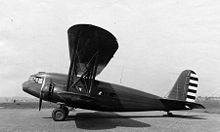Curtiss T-32 Condor II Video - With other Swissair aircraft
|
|
Curtiss T-32 Condor II
T-32 Condor II

Picture - A USAAC YC-30 in 1933
Role: Biplane transport and bomber
Manufacturer: Curtiss Aeroplane and Motor Company
First flight: 1933
Number built: 45
Developed from: B-2 Condor
The Curtiss T-32 Condor II was a 1930s American biplane airliner and bomber aircraft built by the Curtiss Aeroplane and Motor Company. It was used by the United States Army Air Corps as an executive transport.
Development
The Condor II was a 1933 two-bay biplane of mixed construction with a single fin and rudder and retractable landing gear. It was powered by two Wright Cyclone radial engines. The first aircraft was flown on 30 January 1933 and a production batch of 21 aircraft were then built. The production aircraft were fitted out as 12-passenger luxury night sleeper transports. They entered service with Eastern Air Transport and American Airways, forerunners of Eastern Air Lines and American Airlines on regular night services for the next 3 years.
The Colombian Air Force opered three BT-32 equipped with floats in the Colombia-Peru War in 1933.
Two modified T-32s were bought by the United States Army Air Corps (designated YC-30) for use as executive transports. One Condor was converted with extra fuel tanks and used by the 1938 Byrd Antarctic Expedition, and unique for a Condor had a fixed undercarriage to allow use on floats or skis. Some aircraft were later modified to AT-32 standard with variable-pitch propellers and improved engine nacelles. The AT-32D variant could be converted from sleeper configuration to daytime use with 15 seats. Four T-32s operating in the United Kingdom were impressed into service with the Royal Air Force at the outbreak of the World War II.
Eight bomber variants (BT-32) were built with manually-operated machine gun turrets in the nose and above the rear fuselage. All these aircraft were exported. A military cargo version (CT-32) was also built for Argentina. It had a large loading door on the starboard side of the fuselage.
Variants

Picture - A USAAC YC-30 in 1933.
T-32
Production luxury night sleeper, 21 built including two as YC-30s
T-32C
Ten T-32s modified to AT-32 standard.
AT-32A
Variant with variable-pitch propellers and 710 hp (529 kW) Wright SCR-1820-F3 Cyclone engines, three built.
AT-32B
An AT-32 variant with 720 hp (537 kW) Wright SCR-1820-F2 Cyclone engines, three built.
AT-32C
An AT-32 variant, one built.
AT-32D
An AT-32 variant with 720 hp (537 kW) Wright SCR-1820-F3 Cyclone engines, one built.
AT-32E
AT-32 variant for the United States Navy as the R4C-1, two built.
BT-32
Bomber variant, eight built.
CT-32
Military cargo variant with large cargo door, three built.
YC-30
United States Army Air Corps designation for two T-32s.
R4C-1
United States Navy designation for two AT-32Es (one for United States Marine Corps) both later to the United States Antarctic Survey.
Operators
Civil operators
Chile
LAN-Chile three former American Airlines examples
Switzerland
Swissair
United Kingdom
Eastern Air Transport operated T-32 variant.
International Air Freight, Croydon operated four T-32s.
United States
American Airways
Eastern Air Transport
Military operators
Argentina
Argentine Naval Aviation operated 3 aircraft of the CT-32 variant.
China
Chinese Nationalist Air Force operated BT-32 variant.
Colombia
Colombian Air Force operated BT-32 variant.
Peru
Peruvian Air Force operated BT-32 variant.
United Kingdom
Royal Air Force - Four T-32 variants impressed from International Air Freight. Not used in service and scrapped at No 30 Maintenance Unit. RAF Sealand.
United States
United States Army Air Corps operated two YC-30 aircraft.
United States Marine Corps received one R4C-1 aircraft.
United States Navy received one R4C-1 aircraft.
Specifications (BT-32)
General characteristics
Length: 49 ft 6 in (15.09 m)
Wingspan: 82 ft 0 in (24.99 m)
Height: 16 ft 4 in (4.98 m)
Wing area: 1,276 ft² (118.54 m²)
Empty weight: 11,233 lb (5,095 kg)
Gross weight: 17,500 lb (7,938 kg)
Powerplant: 2 x— Wright SCR-1820-F3 Cyclone radial piston engine, 710 hp (529 kW) each
Performance
Maximum speed: 176 mph (283 km/h)
Range: 840 miles (1,352 km)
Service ceiling: 22,000 ft (6,705 m)
Armament
5 x— flexible 0.3 in (7.62 mm) M1919 Browning machine guns
1,680 lb (762 kg) Bombs
Accidents and incidents
On 27 July 1934, Swissair Condor CH-170 broke up in mid-air and crashed at Tuttlingen, Germany killing all 12 passengers and crew.
Andrade, John M. U.S.Military Aircraft Designations and Serials since 1909. Earl Shilton, Leicester, UK: Midland Counties Publications, 1979. ISBN 0-904597-22-9. (Page 63 and 214)
Bowers, Peter M. Curtiss Aircraft 1907-1947. London: Putnam & CompanyLtd., 1979. ISBN 0-370-10029-8.
Taylor, H.A. "The Uncompetitive Condor" AirEnthusiast Six, March-June 1978. Bromley, Kent, UK: Pilot Press Ltd., 1978.
The Illustrated Encyclopedia of Aircraft (Part Work 1982-1985). Orbis Publishing, 1985.
Curtiss T-32 Condor II Pictures
More aircraft.
Source: WikiPedia